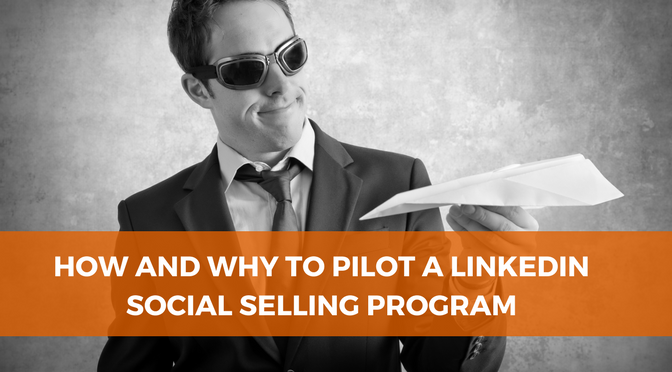How and Why to Pilot a LinkedIn Social Selling Program
Is “social selling” just one more way to distract your sales team, taking you even further away from reaching quota while consultants make a big dent in your sales budget? Or could it actually make your sales people more effective, better at reaching hard-to-get-to prospects, able to find more sales opportunities, ultimately making their numbers?
First the bad news: LinkedIn social selling is not a quota-busting magic bullet that will suddenly solve all the problems for a struggling sales force. Now the good news: companies report extremely positive results when using social selling – leveraging professional networks to establish and build trusted relationship with potential buyers – correctly.
Read more about reasons to embrace social selling here.
But you don’t need to jump into the deep end without first making sure LinkedIn social selling will work for you and your team. Before you develop a full-on business case and secure budget, before you invest the time and money training and coaching your entire sales team, why not know for sure what you’re getting into in terms of resource requirements to make social selling actually work.
Will LinkedIn social selling work for you?
A successful pilot will show that you can find and engage prospects and move them toward an off-LinkedIn sales conversation or demo, and that you can do it cost-effectively and without taking too much time away from selling.
If LinkedIn social selling is going to help you reach your sales objectives, it’s got to meet three requirements:
Your prospects are using LinkedIn. This becomes less and less of an issue everyday – especially in a complex B2B sale, but there are some target audiences that just haven’t made it to LinkedIn yet. In the four years I’ve been running LinkedIn sales and marketing programs, I’ve run across one.
You are able to reach and engage them on LinkedIn. LinkedIn is becoming more crowded by the minute – literally. LinkedIn claims it’s seeing two new members every second. With these crowds comes the usual crap. Spammers, lazy marketers sending the same boring message to everyone. Your team must be able to cut through the noise to gain traction.
There will be an acceptable ROI. Can you generate high quality, eventually closable, leads more cost-effectively with the help of LinkedIn?
Ultimately, success is a combination of your industry, your sales process, sales management, executive buy-in and – to a certain extent – your marketing department’s ability to lay a solid branding foundation on LinkedIn.
How the pilot works
Technically you could run a social selling pilot with one sales person (and we often do this for smaller sales teams), but there is a risk that your selected participant is either a) unusually good at adapting to social selling or b) unusually bad at it. A pilot team of a minimum three-to-five people is a safer number.
There are seven elements or activities that form a solid social selling effort, and each of these should be included in your pilot. As you ramp up the pilot, these activities can be introduced one at a time. Eventually each element, except the profile reframing, runs simultaneously.
Predictably successful social selling programs include:
New personal profiles - reframed to make participants more appealing to customers and prospects
Research to identify target companies and locate the appropriate individuals within those companies
Outreach to get connected to or engaged with the prospects
Use of Sales Navigator to track accounts and leads, and taking action on appropriate trigger events.
A messaging sequence that helps prospects move toward a sales call
Participation in LinkedIn groups
High value content
How long does it take to see results?
Not surprisingly, the amount of time it takes to begin generating interest from your prospects depends on multiple factors. The shortest successful pilot we’ve run has been four months. Six is better.
But you don’t have to wait that long to see evidence of your efforts producing valuable results. These success indicators happen much more quickly:
Net new connections. The ability to find the right people and get connected to them is critical, and you’ll see personal networks beginning to grow as soon as outreach begins. It can take a day or two – or even a week or a couple of months – for people to accept connection requests; but with a successful pilot you’ll see networks beginning to grow immediately.
Profile views. As pilot participants become more active on LinkedIn, the number of people viewing their profiles goes up. This visibility is an indication that people are interested. With a paid LinkedIn account or a Sales Navigator license you’ll be able to see who those people are to know whether or not they are relevant.
Engagement on status updates and posts. Likes and shares are another indication that you’re hitting on topics of interest; and when those likes and shares come from potential new customers, you’re that much closer to a phone call.
Ultimately, of course, you’re looking to get your salespeople in front of prospects – or at least on the phone with them; and, finally, to close a deal. In a complex selling situation, the actual close can take months, even years; so hard ROI data may lie further down the road.
Getting started
If you got the idea that LinkedIn social selling for a complex sale is more involved than simply turning your sales team loose on LinkedIn, possibly with the benefit of a Sales Navigator license, you read me right! It takes a strong understanding of how LinkedIn works as a sales tool along with some structure and patience.
We’re here to help. The Conversion Company has been managing LinkedIn social selling pilot programs since before “social selling” was even an emerging buzzword. To talk about whether or not, and how, a social selling pilot can help you and your team, go ahead and contact us.

